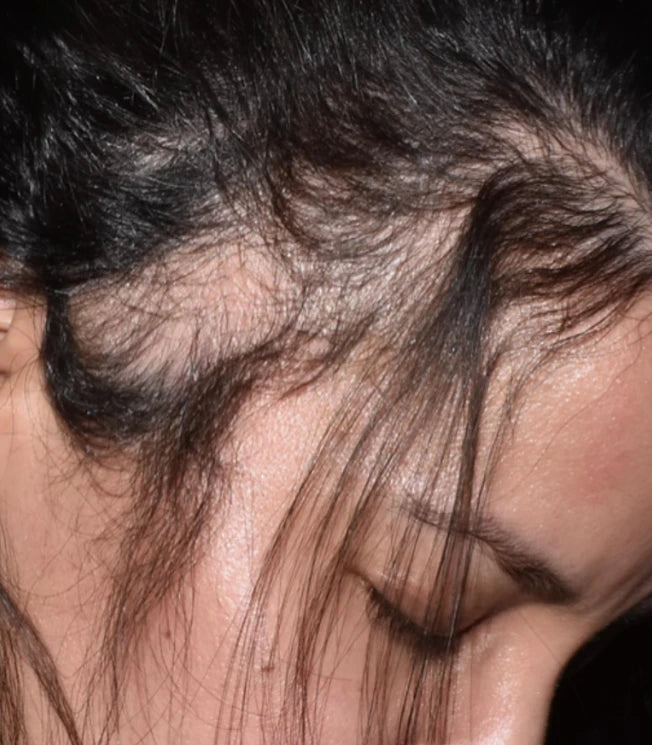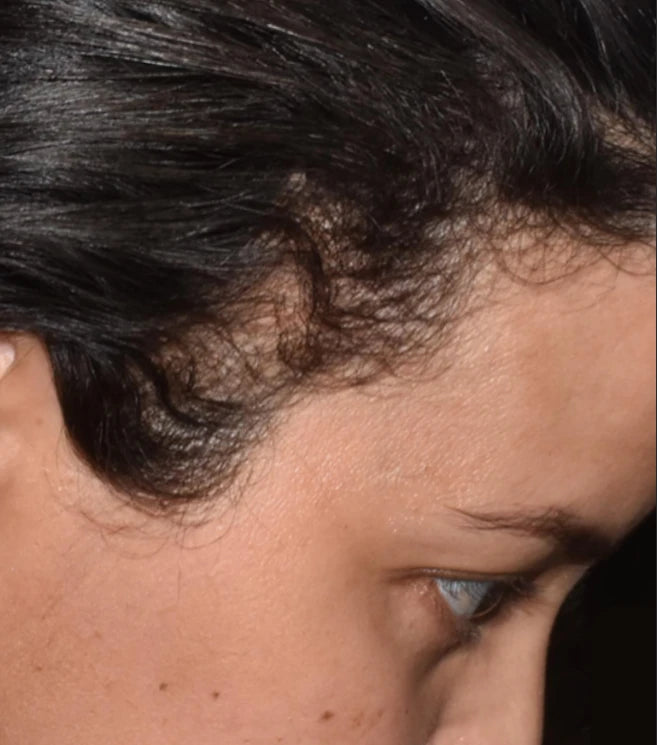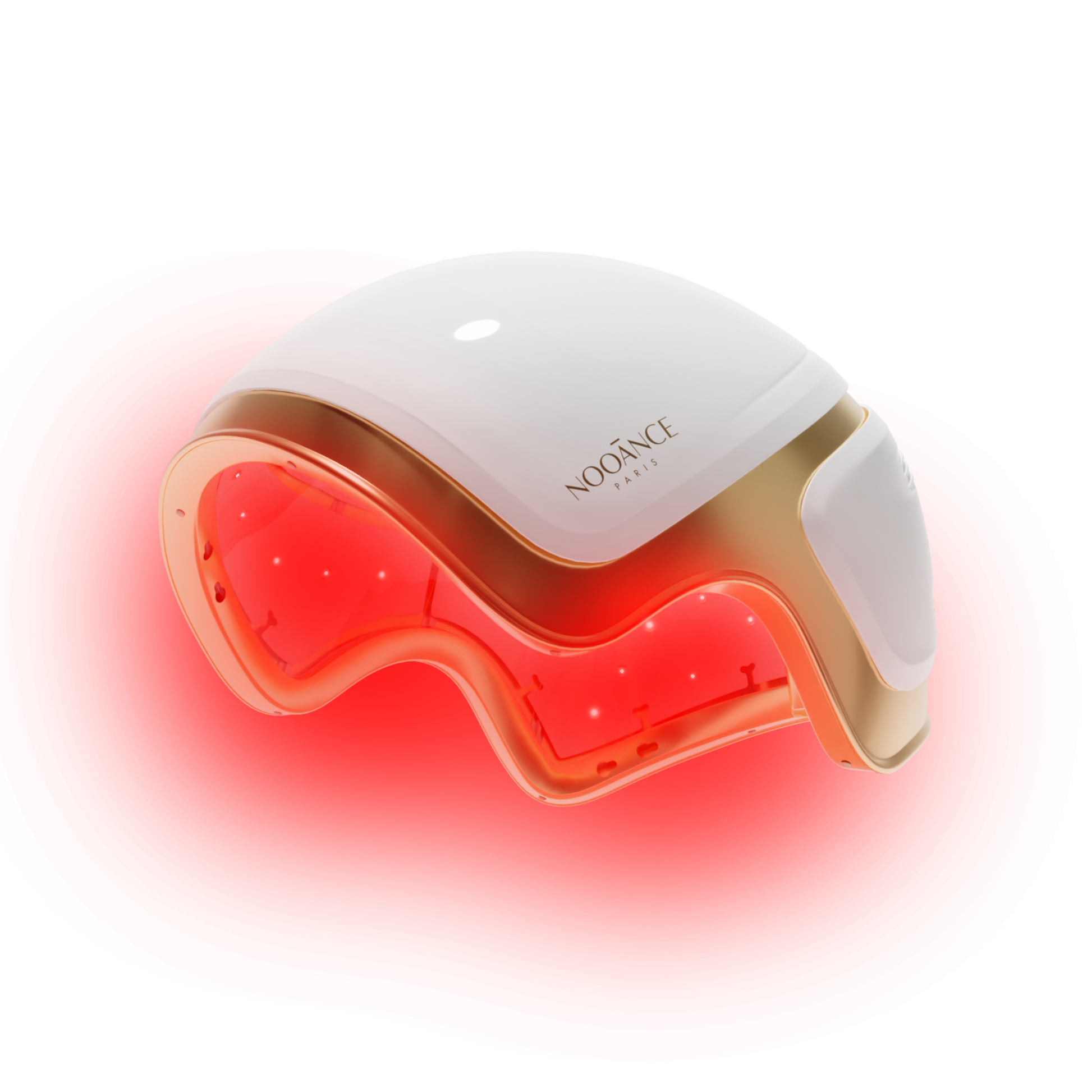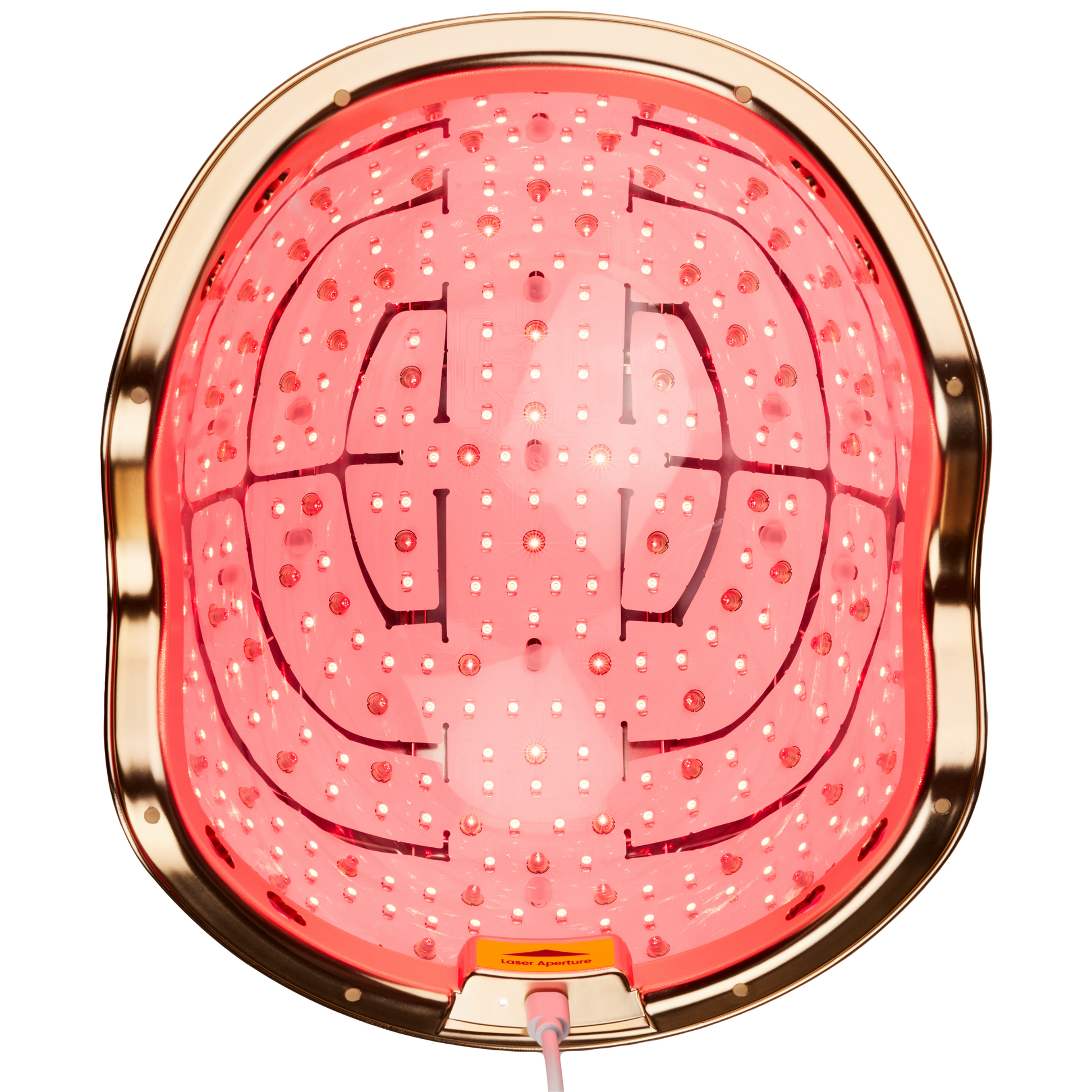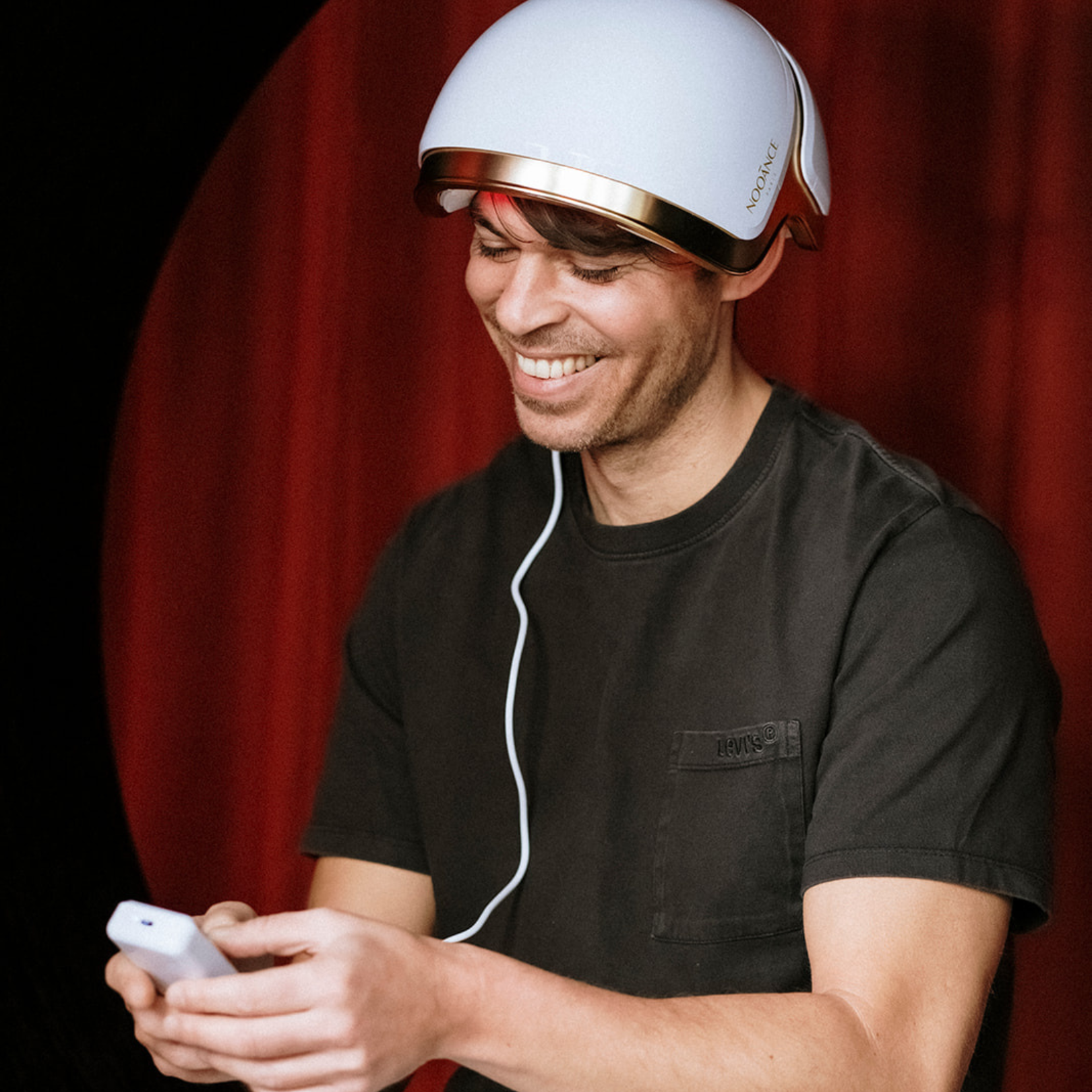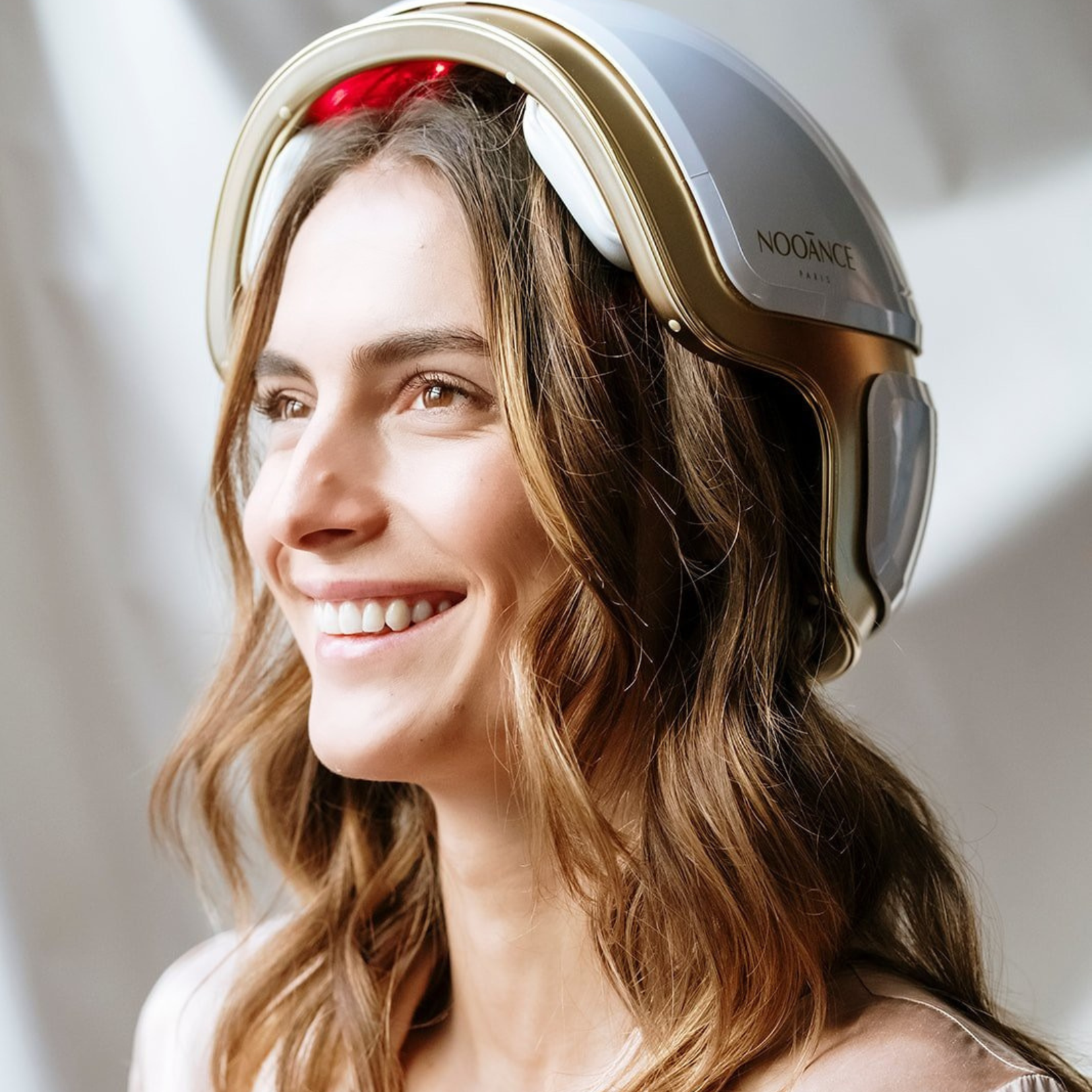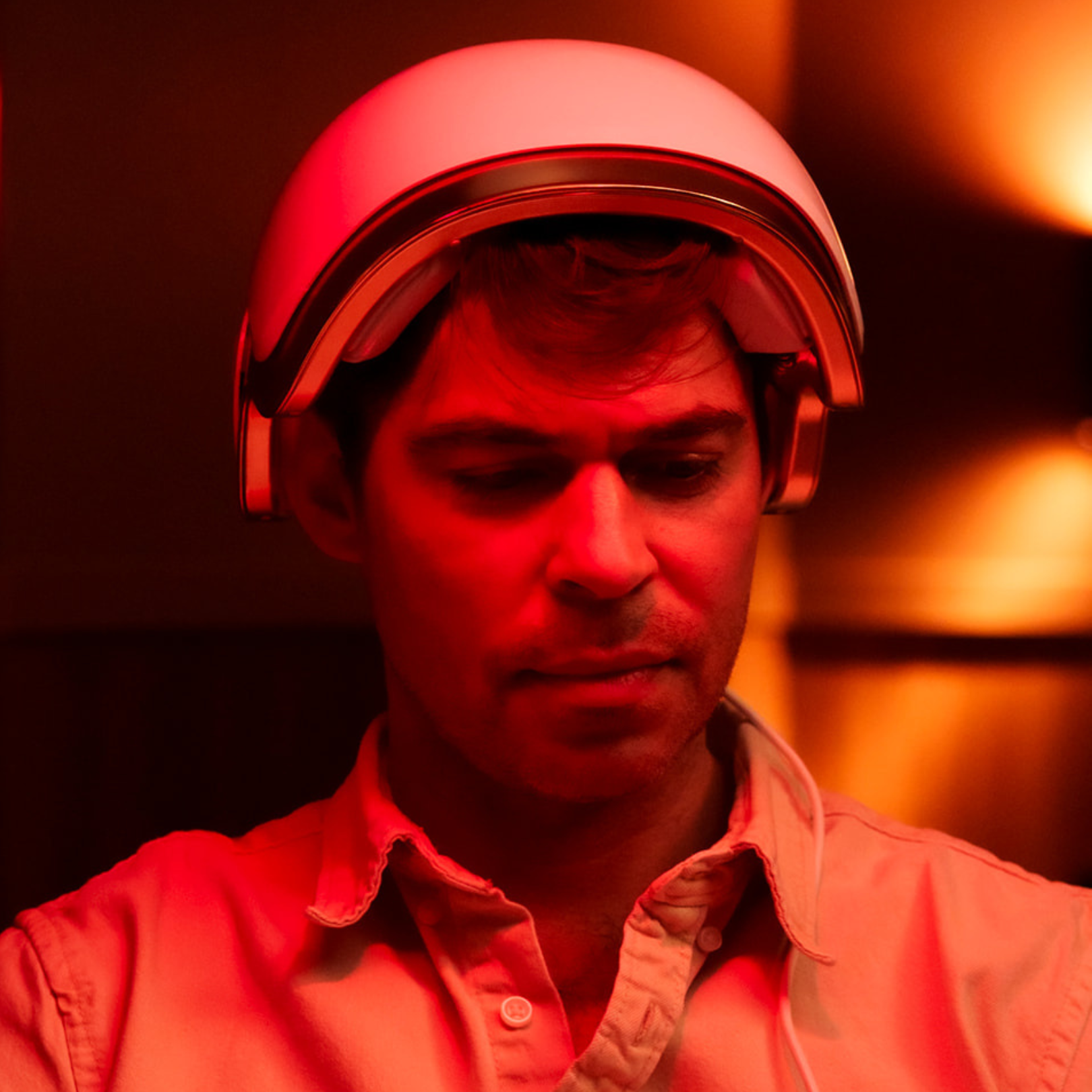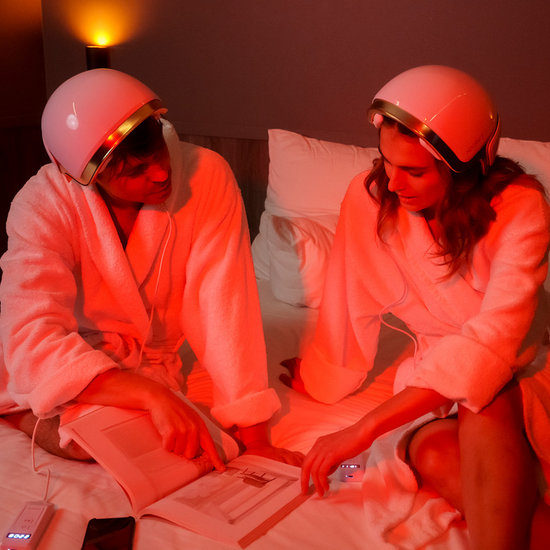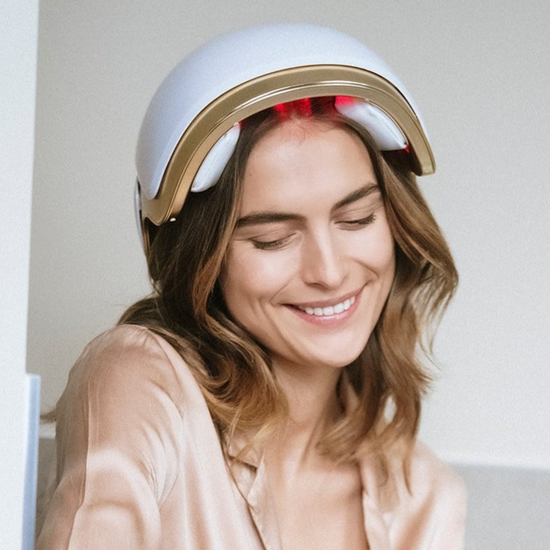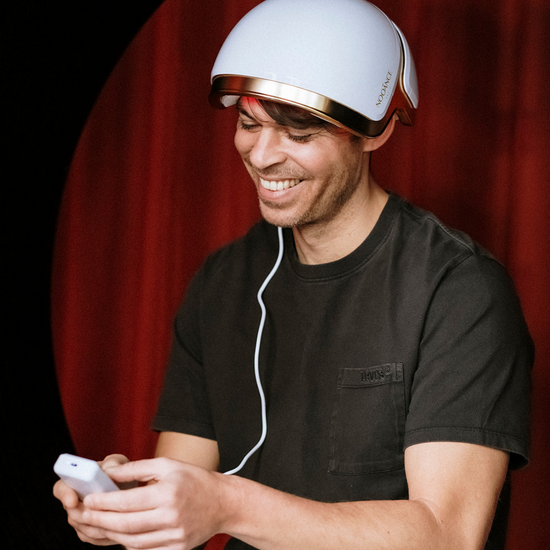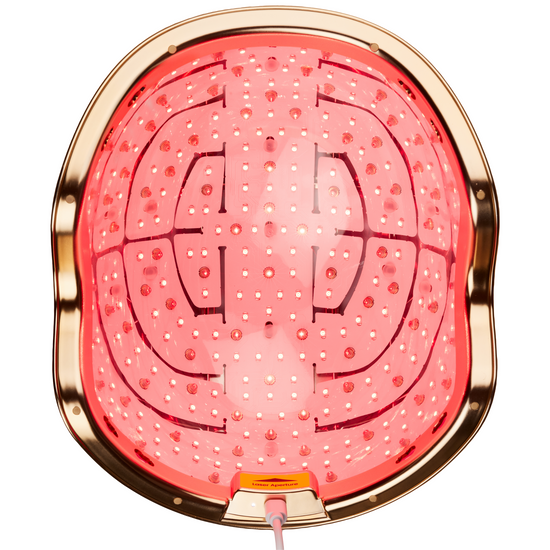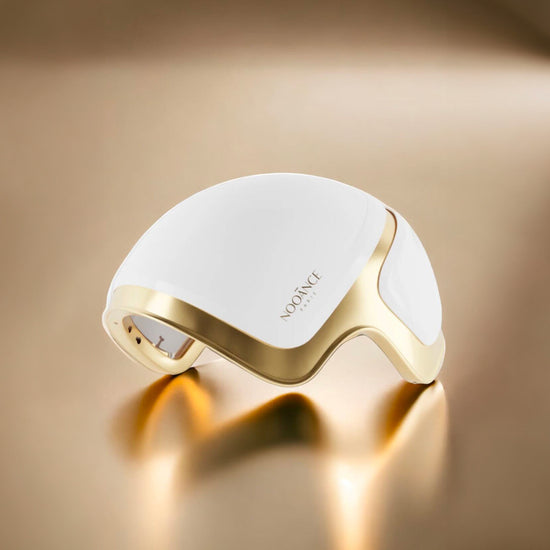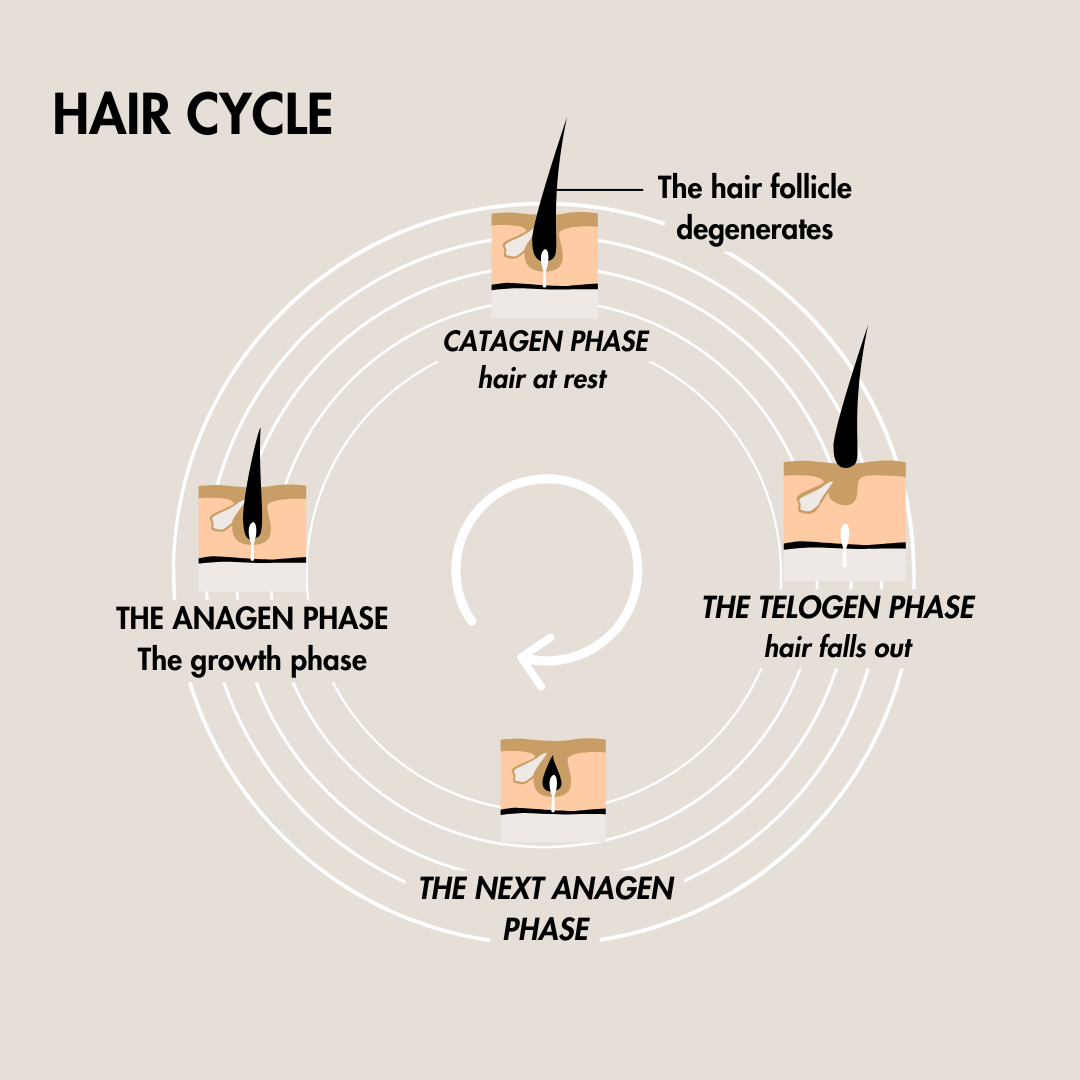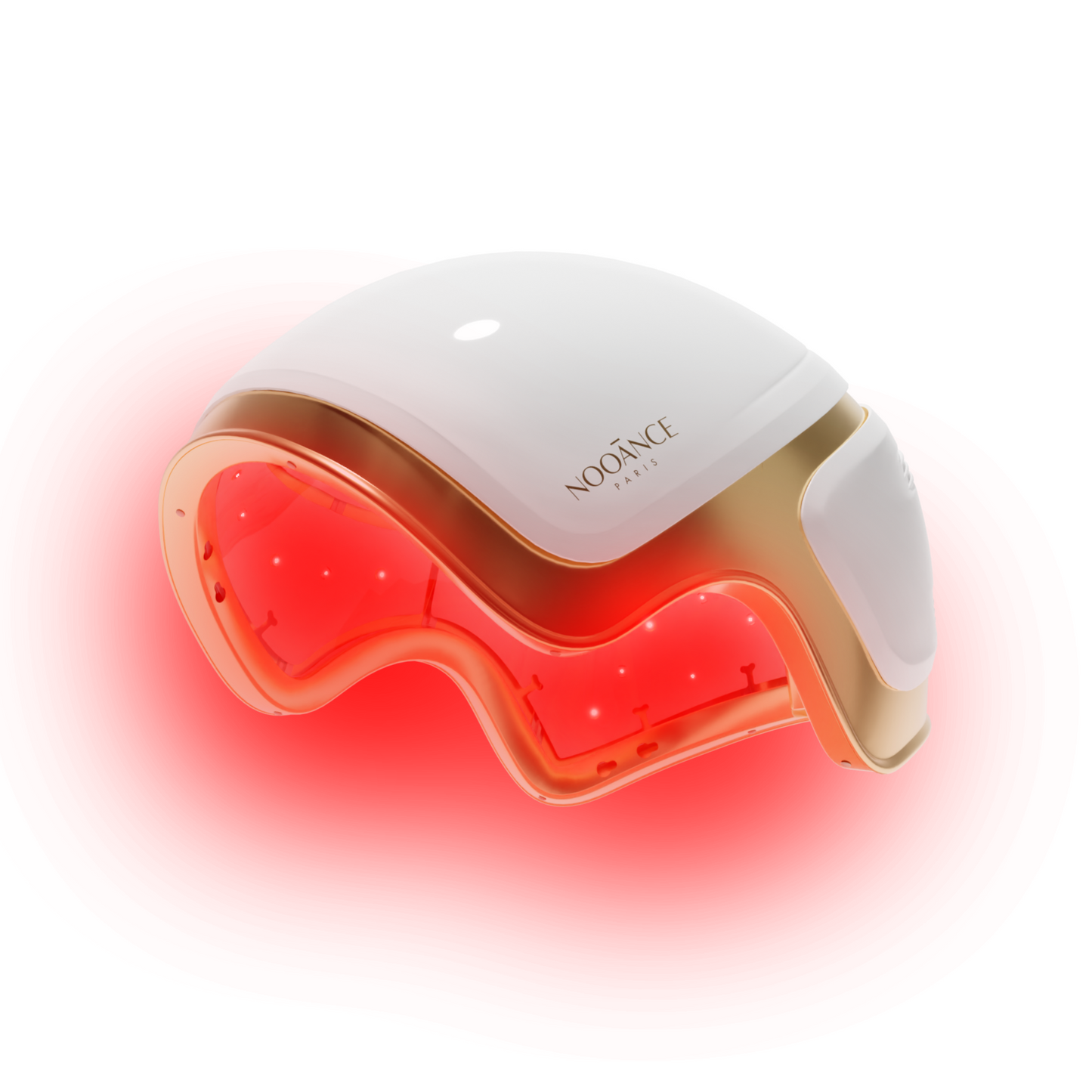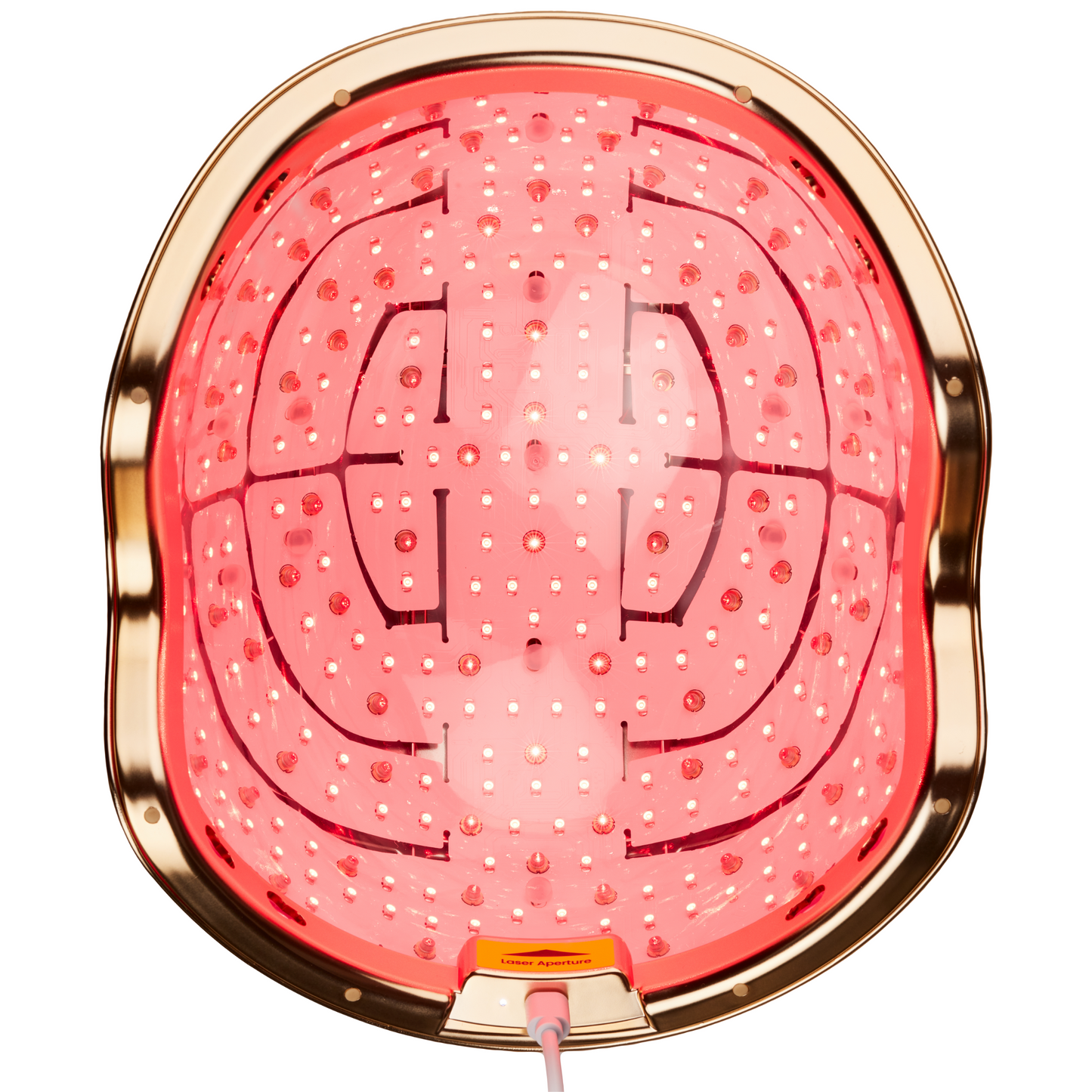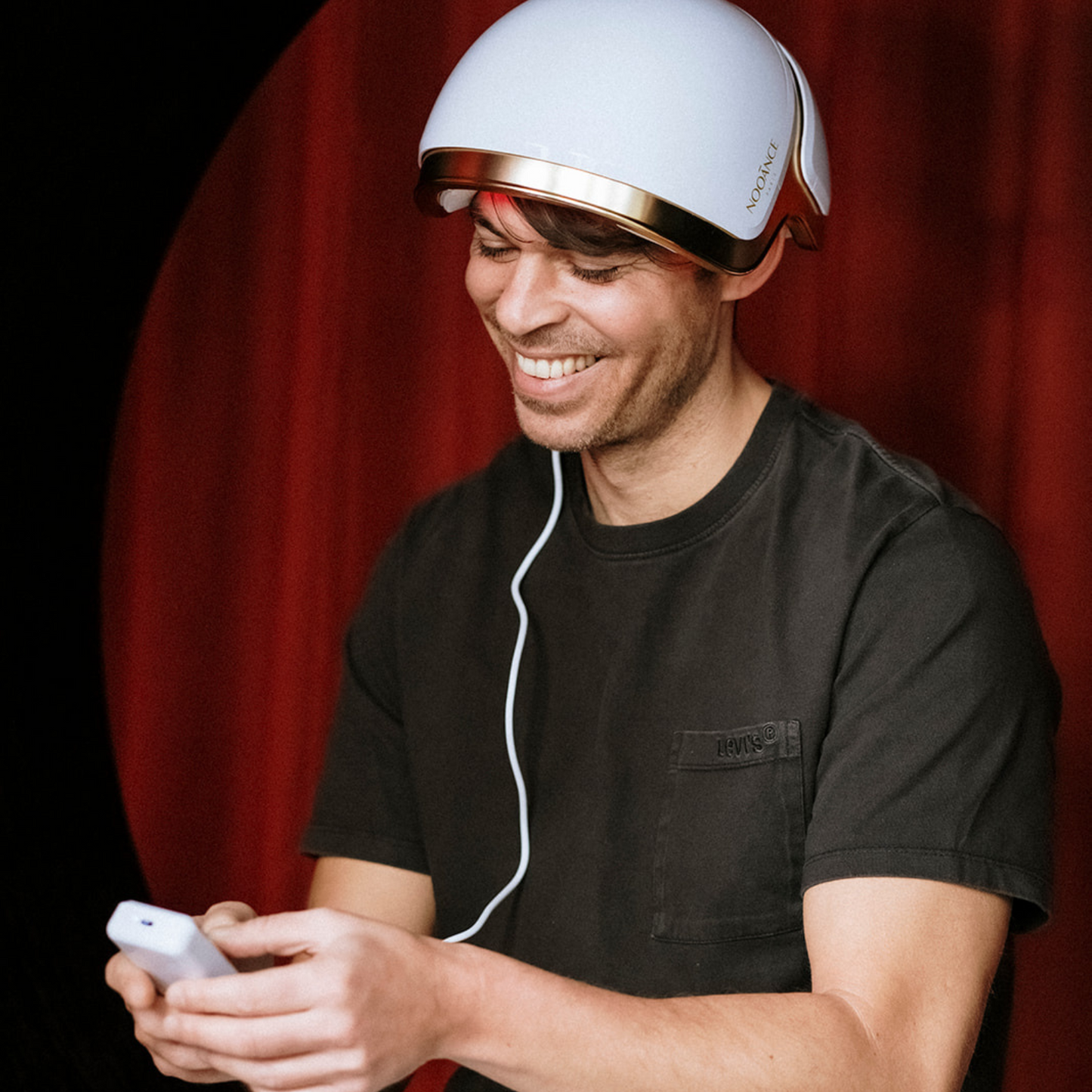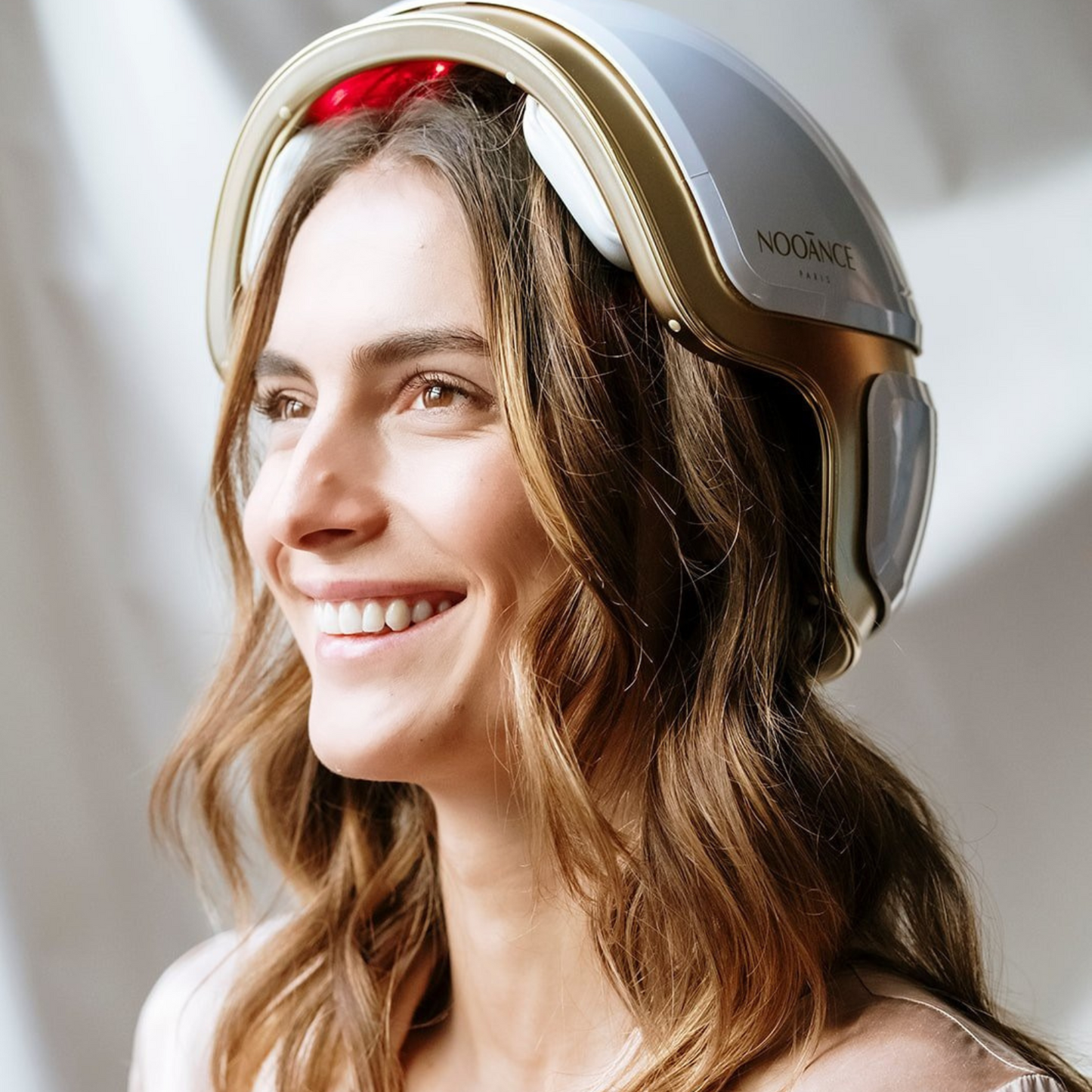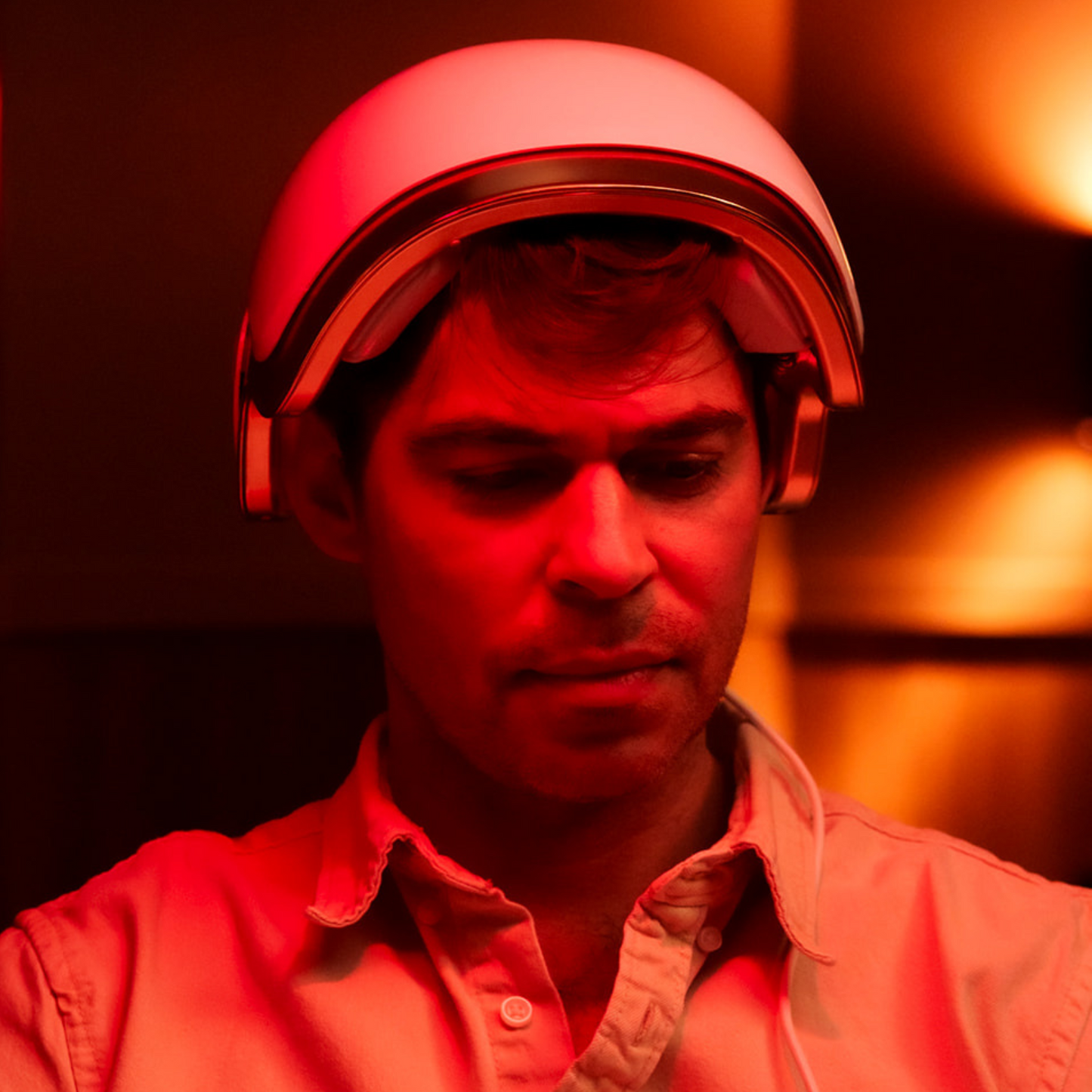A unique dual technology LEDs and Lasers LLLT
Our helmets use a combination of LED and LLLT (Low Level Laser Therapy) technologies to maximize the effectiveness of hair regrowth . The wavelengths between 650 and 655 nanometers emitted are among the best documented and most studied in the scientific community for their benefits on hair bulbs and the scalp .
These clinical studies attest to their effectiveness in ensuring healthy and vigorous hair regrowth. This wavelength range optimally targets and stimulates hair follicles , promoting renewed hair growth and improving the overall condition of the scalp.

Remarkable results
- Intensely stimulates new hair growth
- Significantly reduces daily hair loss
- Visibly increases the diameter and strength of each hair
- Improves overall scalp health, supporting healthy, strong growth
- Validated by French clinical studies, guaranteeing results. (Gredeco Laboratories)
How it works ?
Learn more
The mechanisms of action of LEDs and lasers for hair bulb stimulation are complex and involve several cellular and molecular processes. Here is a more detailed explanation of the main mechanisms of action:
• Light absorption by chromophores: Chromophores are molecules that can absorb light at certain wavelengths. In hair follicle cells, one of the main chromophores is cytochrome c oxidase, an enzyme found in mitochondria. When 650 nm light emitted by LEDs and lasers is absorbed by cytochrome c oxidase, it results in increased enzyme activity and increased production of adenosine triphosphate (ATP), the main energy source for cells.
• Increased ATP and Cellular Energy: Increased ATP production provides hair follicle cells with the energy needed to support essential metabolic processes, such as cell proliferation and differentiation. This promotes hair growth by stimulating hair follicle cells and keeping them in the anagen (growth) phase for longer.
• Growth factor release: Photobiomodulation induced by LEDs and 650 nm lasers also stimulates the release of growth factors, such as vascular endothelial growth factor (VEGF) and fibroblast growth factor (FGF). These growth factors play a key role in regulating cell growth and survival, promoting cell proliferation and differentiation within the hair follicle.
• Stimulation of microcirculation: Increased ATP production and the release of growth factors improve blood microcirculation around the hair follicles. Improved blood circulation helps deliver more nutrients and oxygen to the hair follicles, supporting hair growth.
• Reduced inflammation: LEDs and 650nm lasers reduce inflammation in the scalp by inhibiting the production of pro-inflammatory mediators, such as cytokines and prostaglandins. Reduced inflammation can contribute to a healthier environment for hair follicles, which promotes hair growth and prevents hair loss.
In summary, the mechanisms of action of LEDs and lasers on hair bulb stimulation are closely related to cellular and molecular processes, such as light absorption by chromophores, increased ATP and cellular energy, release of growth factors, stimulation of microcirculation, and reduction of inflammation. These processes work together to promote hair growth and prevent hair loss by creating an optimal environment for hair follicle function and growth.
It is important to note that the effectiveness of photobiomodulation depends on several factors, such as the wavelength of light, the power, the duration of treatment and the frequency of sessions. In the case of the NOOĀNCE helmet, the combined use of LEDs and 650 nm lasers maximizes the effectiveness of the treatment by providing broad scalp coverage, deep tissue penetration and the potential for increased effectiveness.
Understanding the mechanisms of action of LEDs and lasers on hair bulb stimulation is essential to optimize treatments and offer personalized solutions to people suffering from alopecia. Although results may vary depending on individual characteristics, many users of the NOOĀNCE helmet can observe a significant improvement in hair growth and a reduction in hair loss after regular treatment and in accordance with the recommended use of 4 to 6 months.
Technical characteristics
| Specification | Detail |
|---|---|
| Product Name | Pro Helmet |
| Model No | M-282 |
| Function | Hair Growth |
| Number of LEDs | 200 pieces |
| Number of Lasers | 82 Class 3R Lasers (LLLT) |
| Wavelength | Laser: 650±5 nm Red LED Light: 650±5 nm |
| Total Power | 1910 mw/cm² |
| Treatment Area | 682.3 cm² |
| Irradiance | 2.8 mw/cm² |
| Fluence | 4.2 J/cm² |
| Total Fluence | 2865 J/cm² |
| Treatment Protocol | 25 minutes every other day for 16 weeks |
| FDA | K231321 |
Scientific studies
Expected results and precautions
Users can expect to see visible results as early as 16 weeks of regular use of the NOOĀNCE helmet. However, it is important to note that the effectiveness of treatment may vary depending on the individual and the underlying cause of hair loss.
The NOOĀNCE helmet is generally considered safe and without major side effects. However, some people may feel a slight sensation of warmth or tingling when using the helmet, which is normal (stimulation of blood circulation and oxygenation of cells) and should disappear once the treatment is completed.
It is important to consult a healthcare professional before starting to use the NOOĀNCE helmet, if you have underlying health conditions or are undergoing medical treatment for hair loss. The NOOĀNCE helmet may not be effective for all types of hair loss, especially when the bulbs have died and some people may require more comprehensive medical treatment or a hair transplant.
In conclusion, the NOOĀNCE dual technology laser and LED helmet represents an innovative and science-based solution for those looking to combat alopecia and promote hair regrowth. With the combination of 650nm laser and LED technologies, this helmet maximizes coverage, penetration depth and overall treatment effectiveness. By integrating the NOOĀNCE helmet into your routine and following the recommendations for use, you can achieve visible results and help effectively combat hair loss.
Studies and research:
Several scientific studies and research support the effectiveness of Laser and LED technologies to stimulate hair growth and combat alopecia. You can view some of these studies by following the links below:
- Study on the effectiveness of LEDs and lasers on hair growth
- Role of Low-Level Light Therapy (LLLT) in Androgenetic Alopecia (2021)
- Comparison of low-level light therapy in the treatment of female pattern hair loss (2020)
- Photobiomodulation for the management of hair loss (2020)
- Energy-based Devices for Hair Loss (2021)
- Factors influencing the effect of photobiomodulation in the treatment of androgenetic alopecia: A systematic review and analyzes of summary-level data (2020)
- Low-level laser therapy for the treatment of androgenic alopecia: a review (2018)
- Low-Level Laser (Light) Therapy (LLLT) for Treatment of Hair Loss 2015
- Effects of LEDs in dermatology
- Effect of wavelength and beam width on penetration in light-tissue interaction using numerical methods
How to use it ?
The NOOĀNCE helmet is easy to use completely independently thanks to its Remote Control/Battery and can be easily integrated into your routine .
To achieve the best results, it is recommended to use the helmet every other day, for 25 minutes per session.
Consult the quick use instructions .
OUR CLINICAL STUDIES
Evaluation measured clinically: -195% reduction in hair loss after 6 months of use by self-scoring of subjects (-137% after 4 months and -59% after 2 months).
Use test under dermatological control: A reduction in hair loss for 75% of users after 6 months of use.
*Study carried out by an independent French laboratory on 21 volunteers aged 25 to 55 for 6 months with use every other day (1 session = 25 minutes) using mode 1 (continuous) for the first two months then mode 2 (pulsed) the last four months.
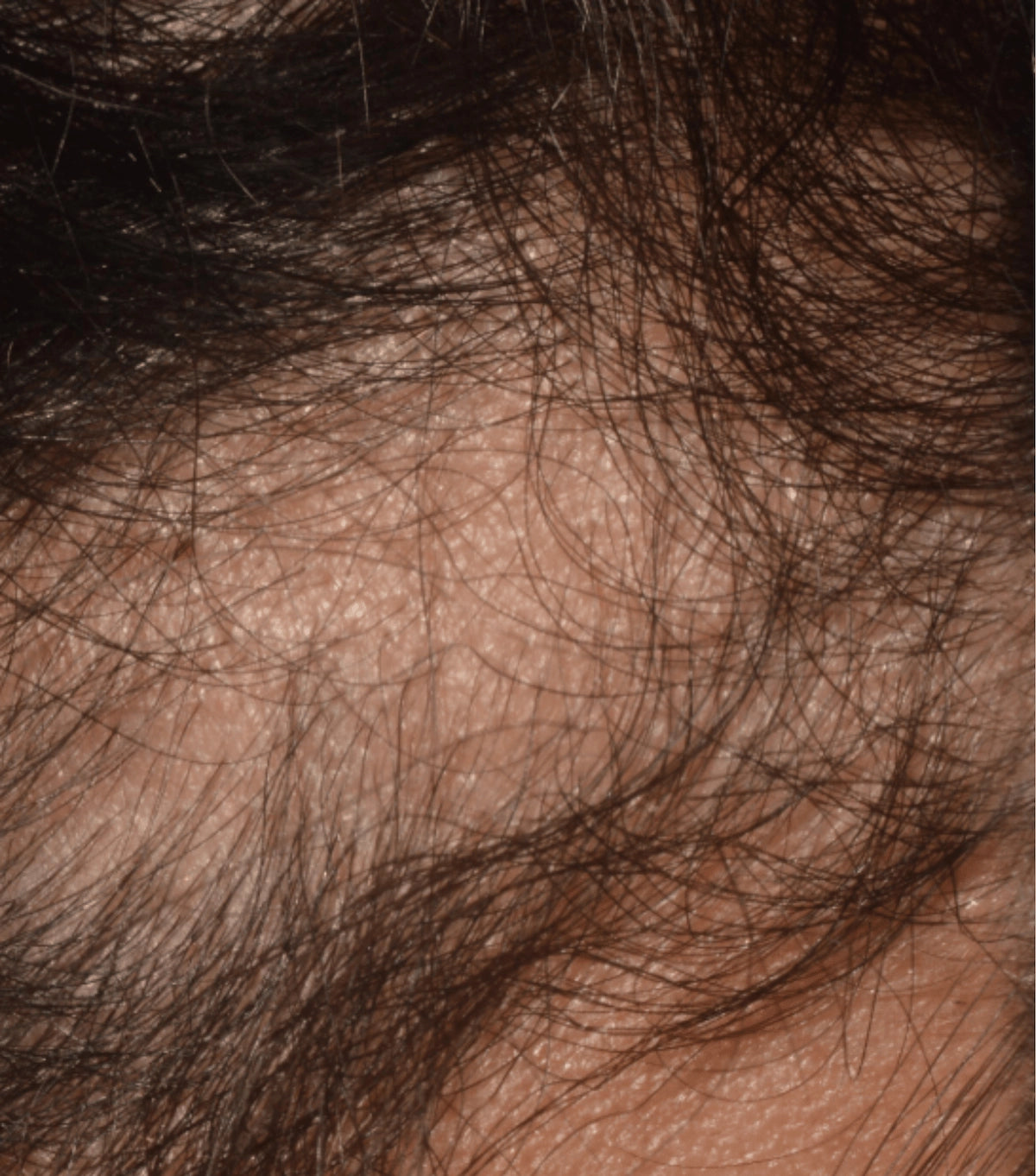
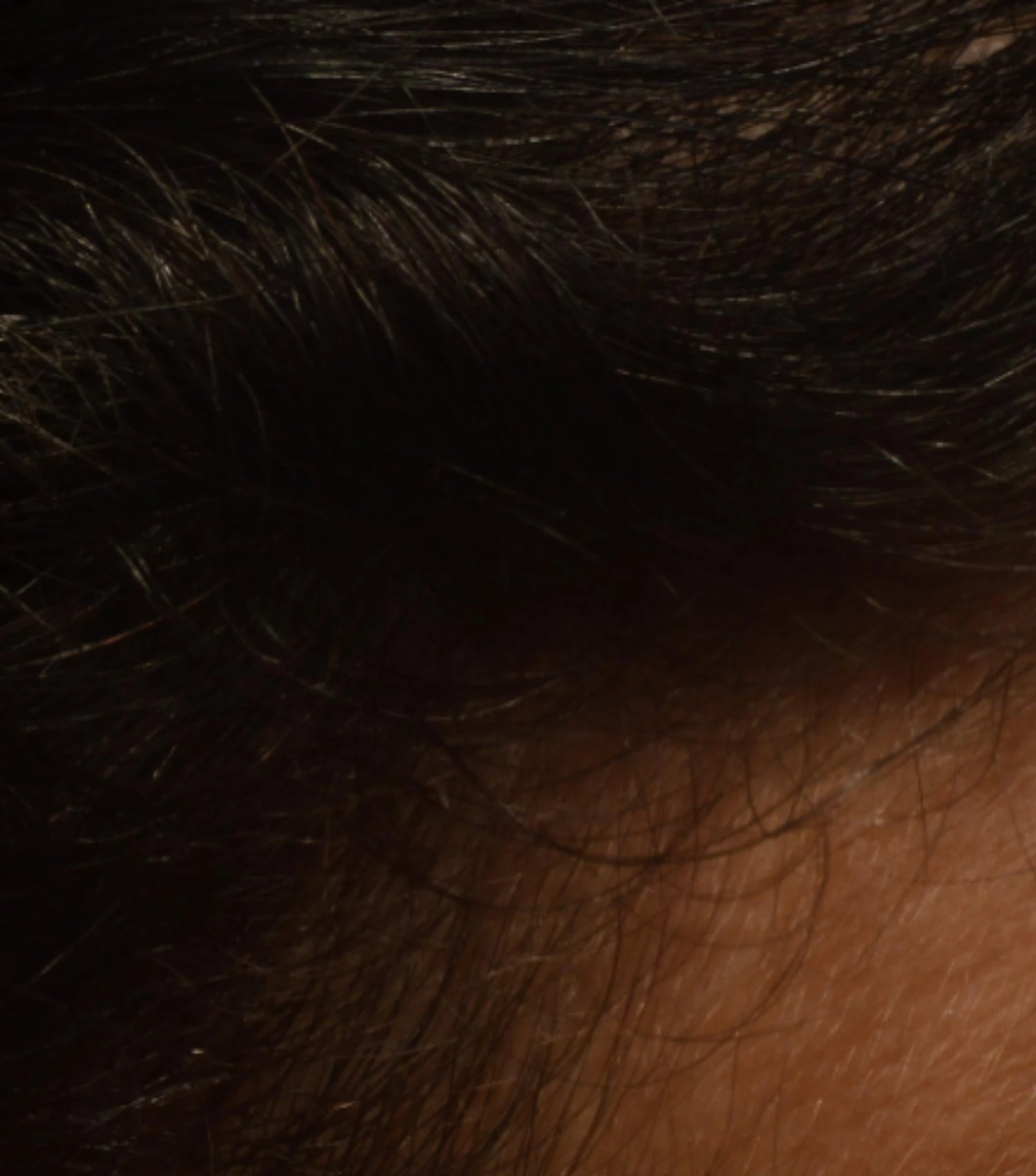
Evaluation measured clinically: +27.9% increase in hair density after 6 months of use by analysis of macrophotographs taken by the Proscope x30 (+25.2% after 4 months and +9% after 2 months).
Use test under dermatological control: Improvement in hair density for 87.5% of users after 6 months of use.
*Study carried out by an independent French laboratory on 21 volunteers aged 25 to 55 for 6 months with use every other day (1 session = 25 minutes) using mode 1 (continuous) for the first two months then mode 2 (pulsed) the last four months.
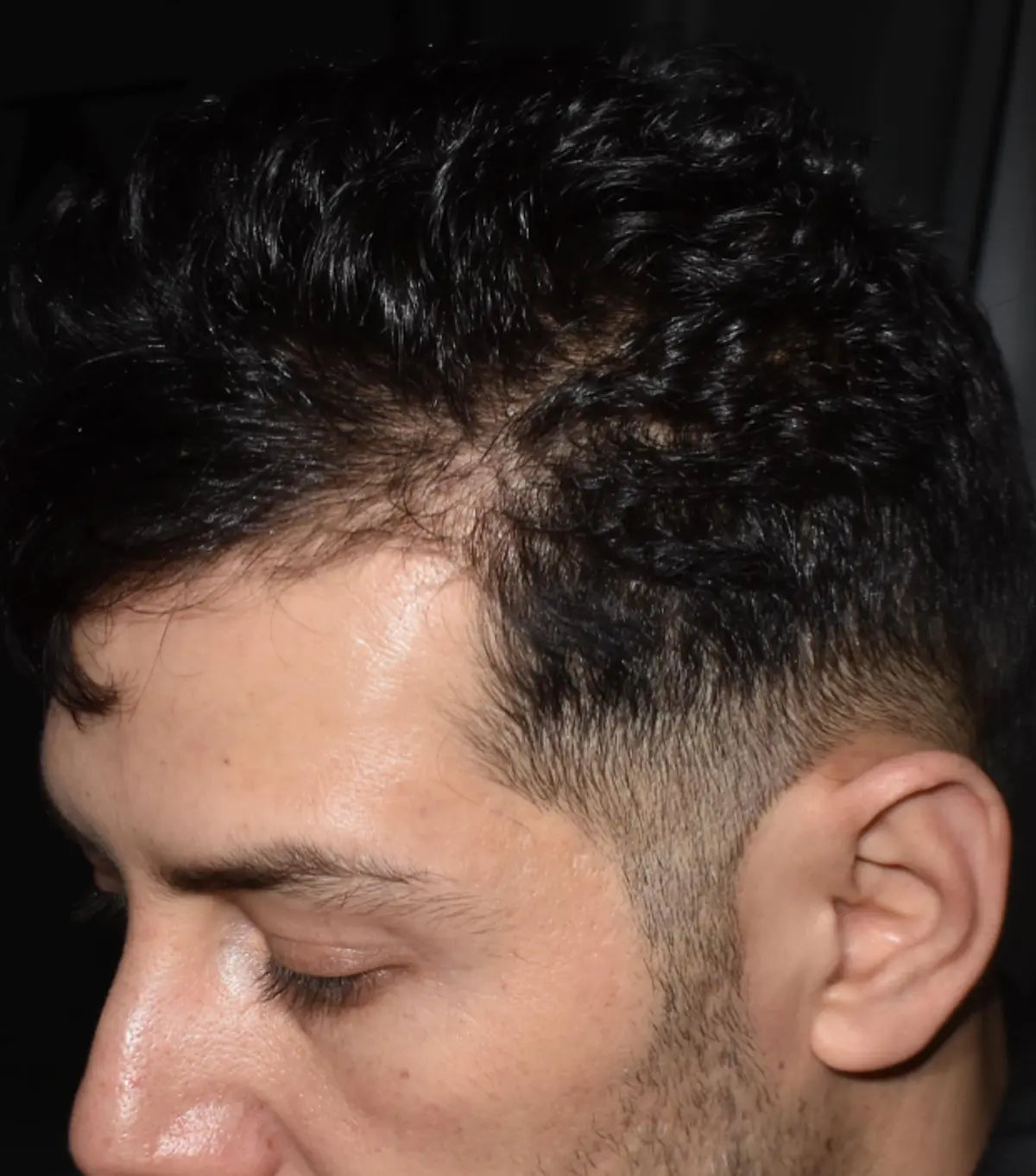
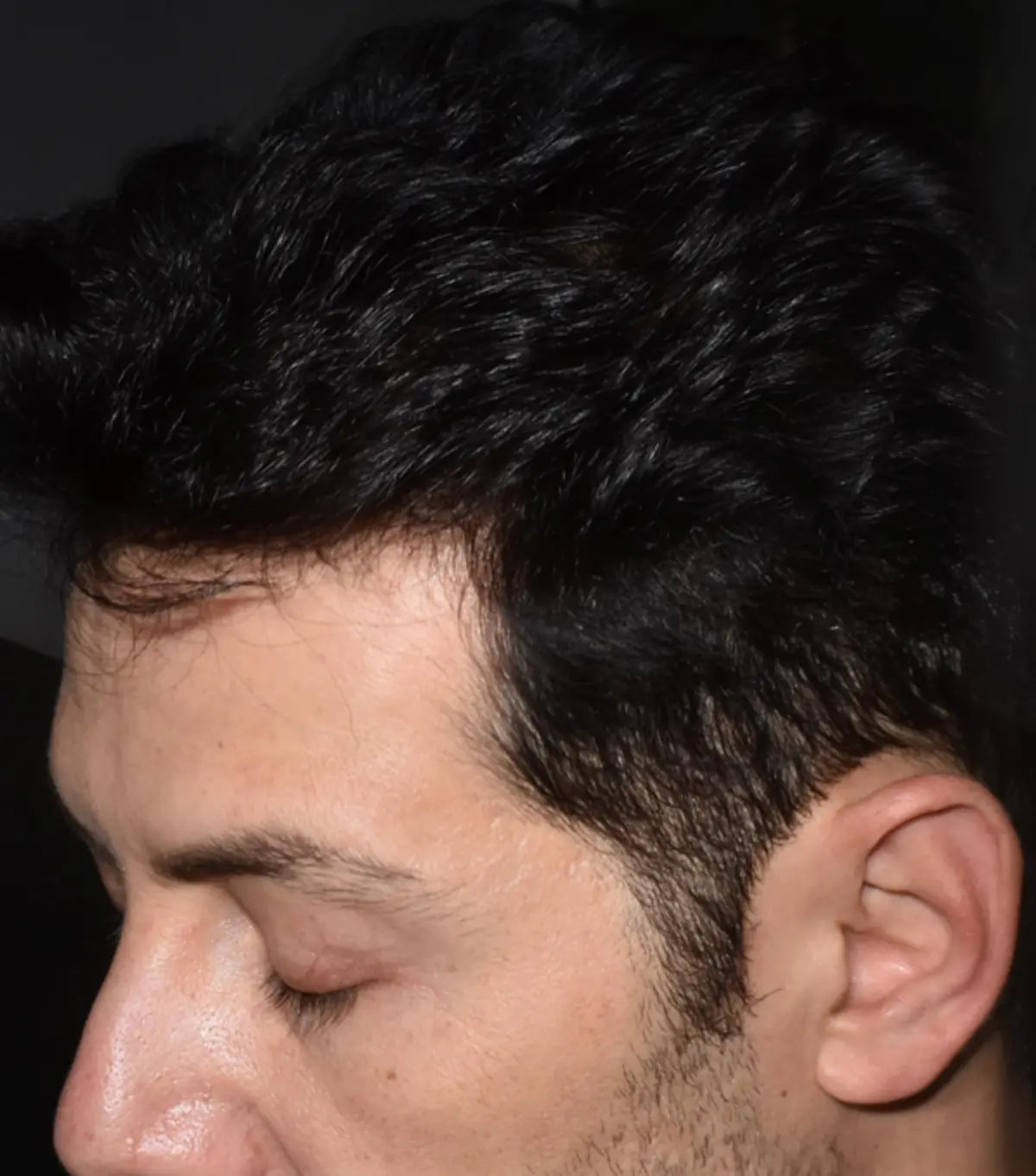
Evaluation measured clinically: +20.8% increase in hair thickness after 6 months of use by analysis of macrophotographs taken by the Proscope x30 (+15.1% after 4 months and +8.2% after 2 month).
Use test under dermatological control: An improvement in the thickness, quality and general condition of the hair for 93.7% of users .
*Study carried out by an independent French laboratory on 21 volunteers aged 25 to 55 for 6 months with use every other day (1 session = 25 minutes) using mode 1 (continuous) for the first two months then mode 2 (pulsed) the last four months.
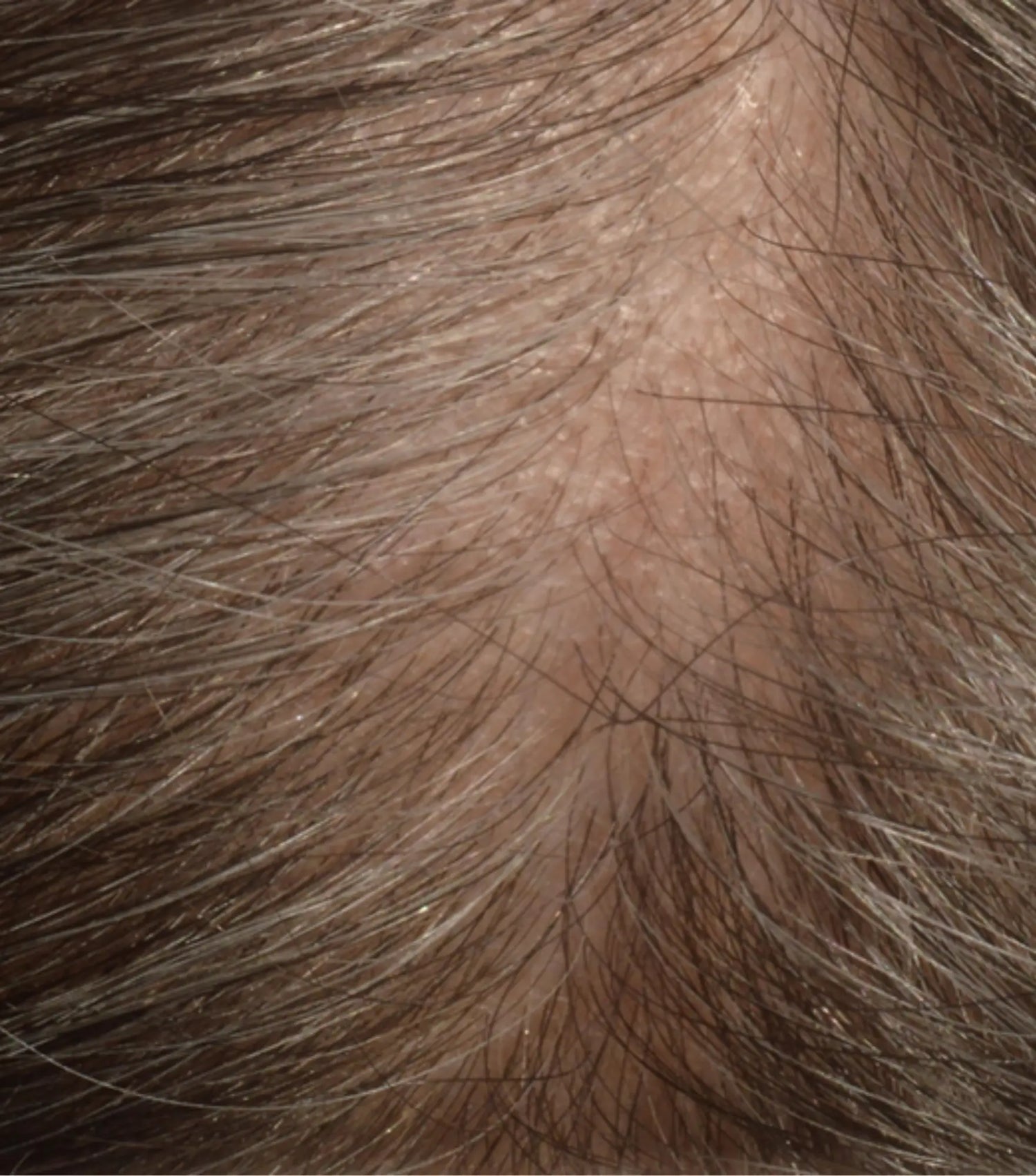
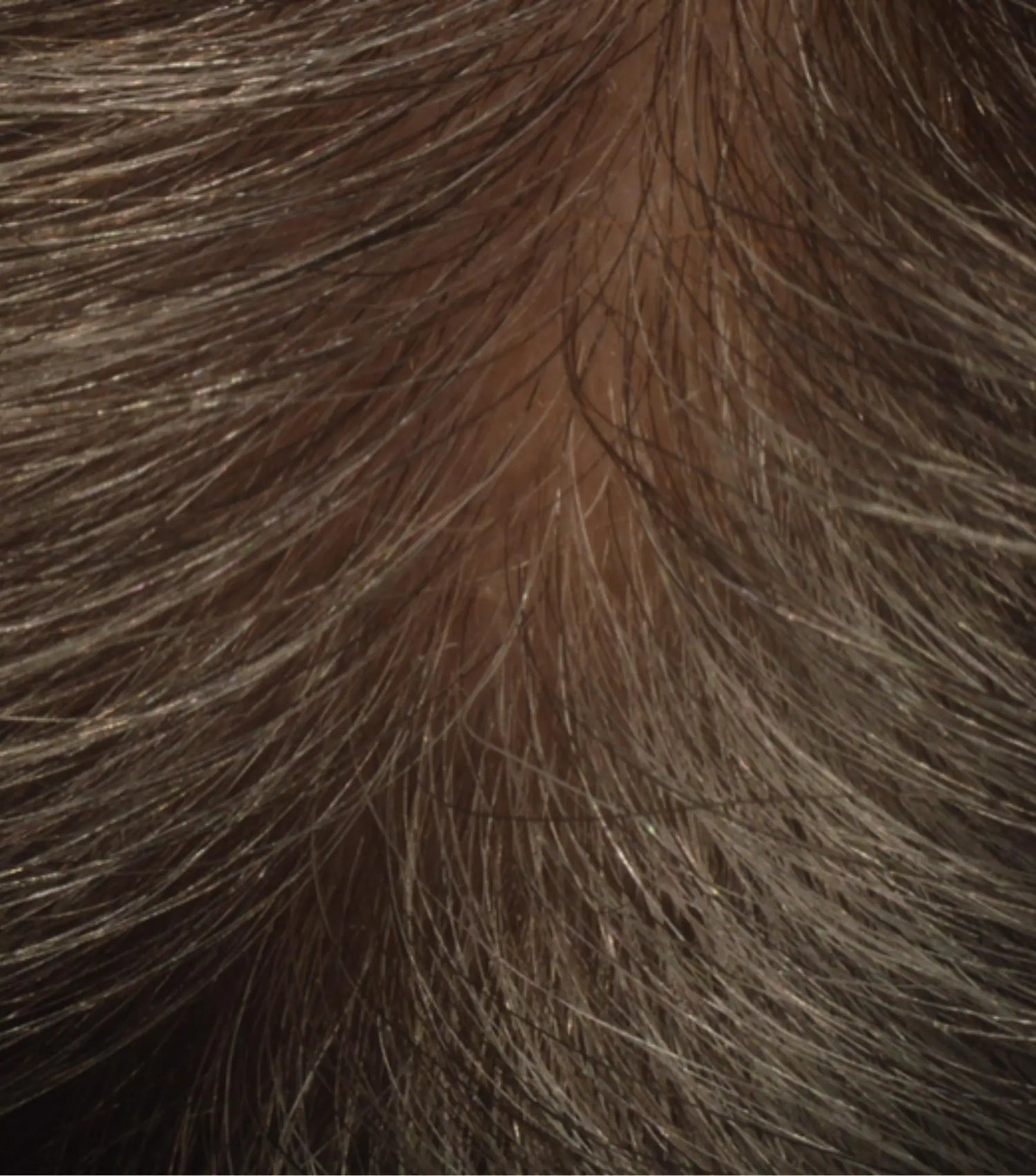
Use test under dermatological control: Improved hair shine for 81.2% of users.
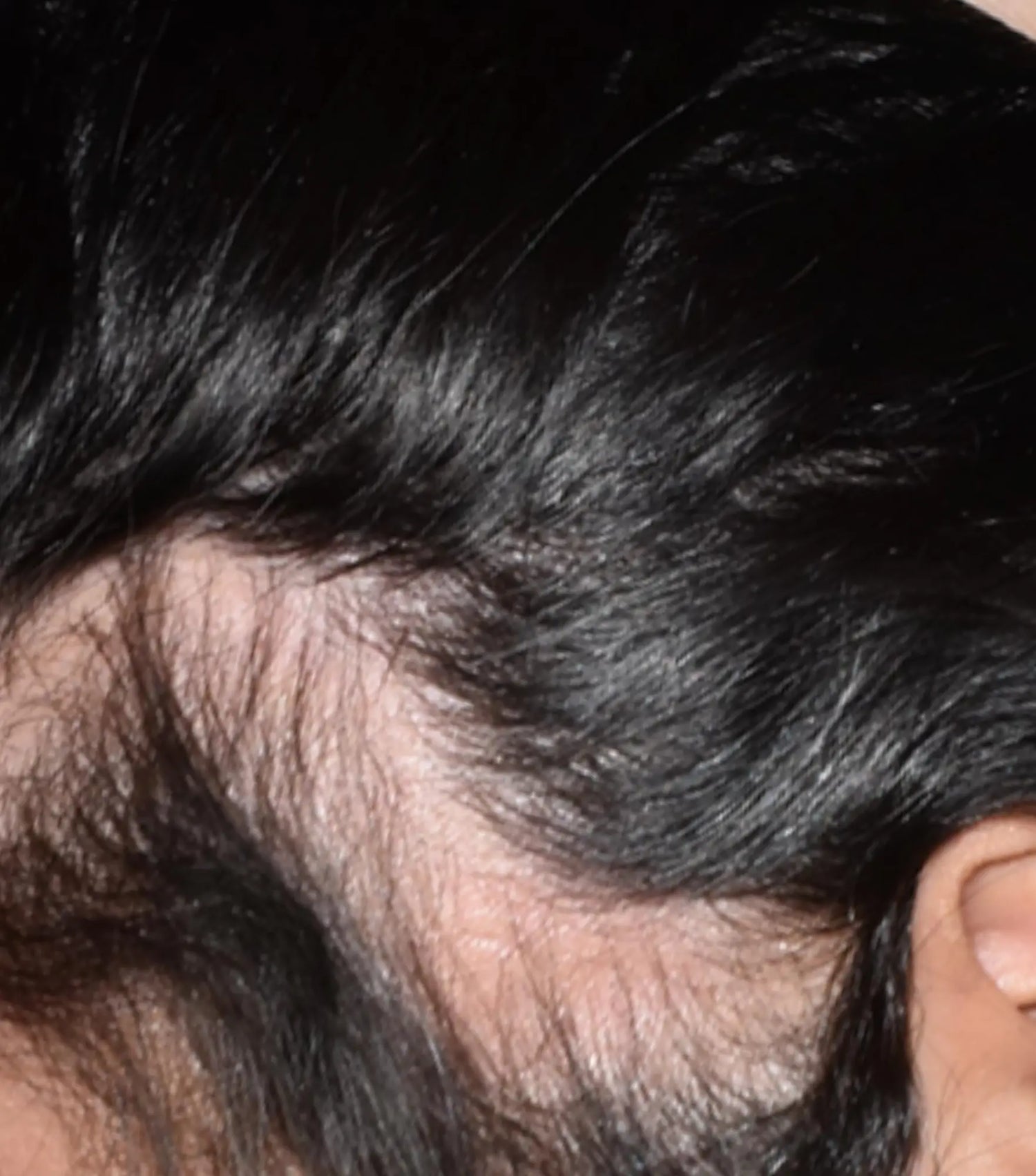
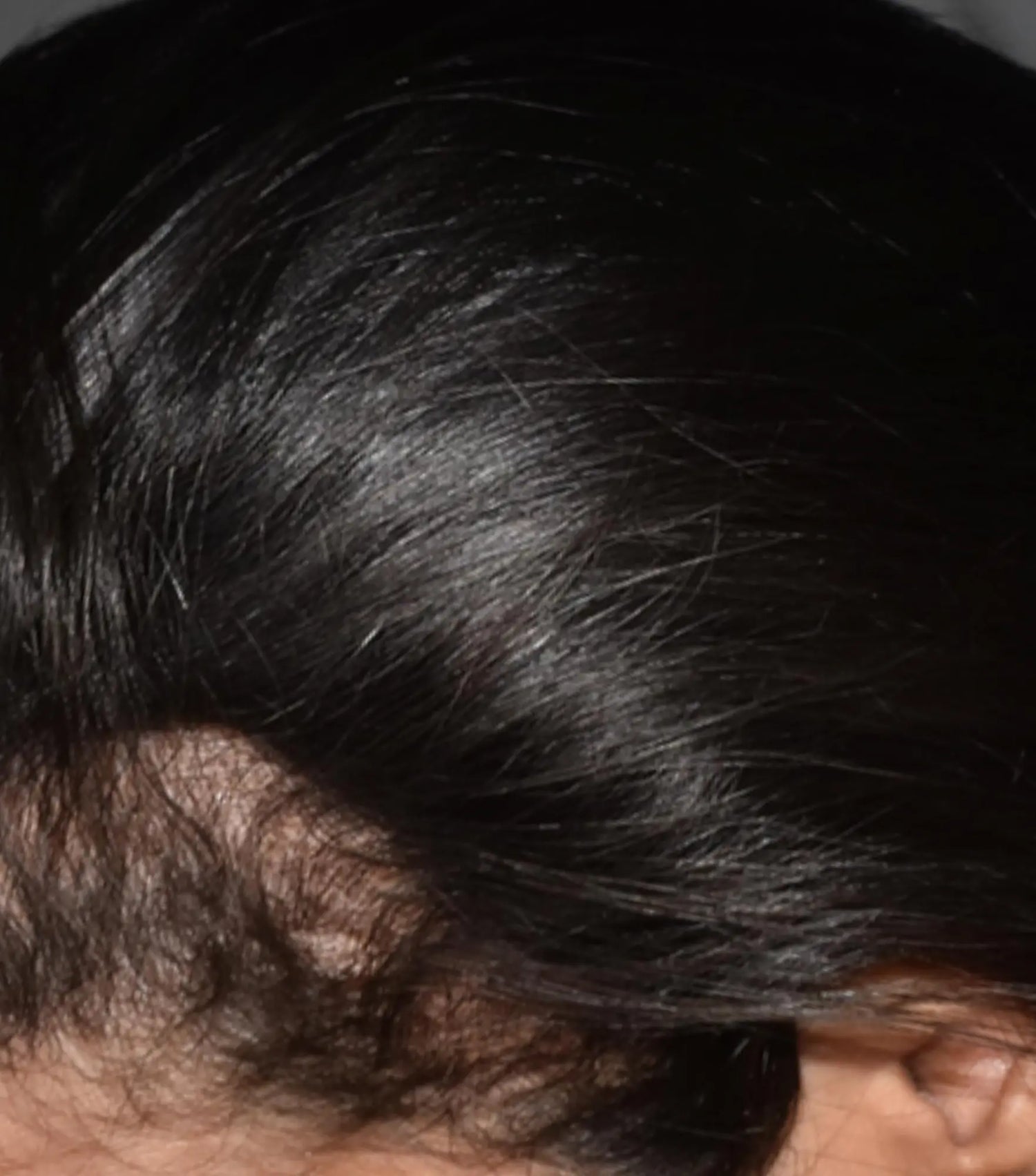
Use test under dermatological control: Improved hair regrowth for 75% of users and improvement in hair growth for 68.7% of users .
